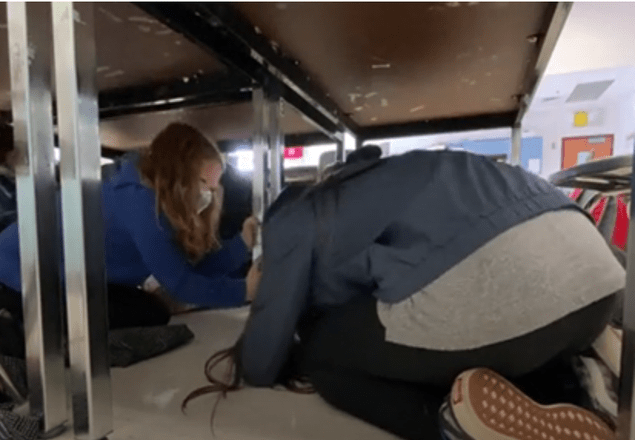
Students in the Stanwood-Camano School District used a ShakeAlert test message to practice “Drop, Cover, Hold On” during an earthquake drill in 2021.
Bringing Earthquake Early Warning into Washington Schools
Because Every Second Counts
Gabriel Lotto, PhD
ShakeAlert Engagement Facilitator, Pacific Northwest Seismic Network, University of Washington
Evaluation Criteria: Ensuring School Safety
We have all heard about “The Big One,” a potential magnitude 9 offshore earthquake that would shake the ground from California to Canada and generate a tsunami that could flood the coast. We may have a vivid memory of the Nisqually earthquake in 2001, which rattled the Puget Sound region and reminded us that earthquakes can happen when we least expect it. We might even know about the potential risk from the Seattle Fault - which runs through Washington’s largest city - or other smaller crustal faults that still can host intense shaking over a smaller area.
For Washington schools, the potential risk from earthquakes is real. We don’t know when the next big earthquake will strike, but we can take action to protect students, staff, and property before it happens. One of the simplest and most effective actions a school district can do to increase their seismic resilience today is to integrate the ShakeAlert earthquake early warning system into their public address systems.
The ShakeAlert earthquake early warning system, developed over the last decade by the U.S. Geological Survey and several university partners (including the University of Washington), launched for public alerting in Washington just last year. ShakeAlert rapidly detects significant earthquakes and estimates the location and strength of the shaking likely to come. Then alerts are delivered to the public by ShakeAlert Technical Partners, a select group of companies and nonprofits licensed by the US Geological Survey to turn raw data about earthquake magnitude and shaking intensity into real-life alerts. This gives people seconds to tens of seconds of warning before shaking arrives at their location.
School districts have a special role to play in earthquake readiness because our community’s children are in our care for seven hours or more each day. The ShakeAlert System helps us meet the challenge of providing a safe learning environment for our students and staff.
Shaking from a significant earthquake is dangerous in a school setting; strong ground motion can topple furniture, collapse ceiling tiles, and toss students and teachers. The advance warning offered by ShakeAlert allows people to prepare for shaking by taking protective action: namely, Drop, Cover, and Hold On. Ten to twenty seconds of warning might not seem like much, but it’s plenty of time to drop under a sturdy desk or table, protect your head and neck, and brace yourself to ride out the shaking. This can be especially important for younger students or those with access and functional needs. That is how ShakeAlert aims to save lives and reduce injuries.
In the Fall of 2019, Stanwood Elementary became the first school in Washington to use ShakeAlert to send earthquake early warning alerts to its staff and students. The Stanwood-Camano School District has since added alerting capability to all 13 of its buildings and connected them to a centralized PA system that is automatically activated when shaking is expected.
Stanwood-Camano school district’s superintendent, Deborah Rumbaugh, has been instrumental in supporting the rollout of ShakeAlert technology in her district. “School districts have a special role to play in earthquake readiness because our community’s children are in our care for seven hours or more each day. The ShakeAlert System helps us meet the challenge of providing a safe learning environment for our students and staff,” says Rumbaugh.
How does a school go about connecting to ShakeAlert? The simplest option is to consult with one of the several companies licensed by the U.S. Geological Survey to be a ShakeAlert Technical Partner. Many of these Technical Partners offer products that can connect to school PA systems, intercoms, or fire alarms - even if your existing infrastructure is 50 years old - for a price that is affordable to any school district. In my capacity as a University of Washington employee working for the ShakeAlert system as a whole, I cannot recommend one of these companies over another (nor would I wish to!). But I can encourage school leaders to reach out to a few of them, start a conversation, and find out what your options are.
An alternate option for connecting to the ShakeAlert System, one that may be appropriate for larger districts with sufficient IT staff, is to become a USGS-licensed Technical Partner yourself, connecting directly to ShakeAlert data servers and pushing alerts through your PA system without employing a third party. This option costs nothing, but probably will require more staff time compared with working with an existing technology provider.
In schools in the Pacific Northwest, earthquakes are twice as likely as fires. Yet, no school is without a fire alarm system. Those of us who work with the ShakeAlert System see earthquake early warning alarms becoming just as ubiquitous as fire alarms in Washington schools within a matter of years. With each school that connects to ShakeAlert, we move closer to a future where all parents know their children are well protected against damaging earthquakes.
To learn more about earthquake early warning in schools, read the ShakeAlert Educational Sector Toolkit. If you need help getting started with ShakeAlert, reach out to me at GLotto@uw.edu and I’ll be happy to work with you.
Find us on
Association of Washington School Principals
Washington Principal | Volume 3 – 2021-22


